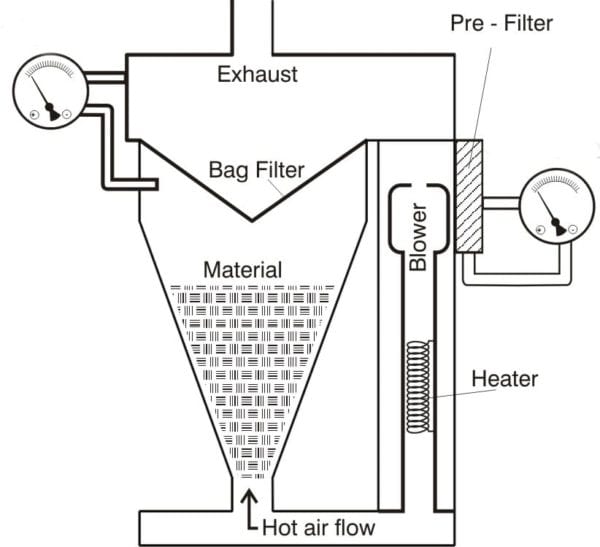In various industries, particularly pharmaceutical, food processing, and chemical manufacturing, the need to efficiently dry small batches of compounds is a common requirement. This process typically involves the use of specialized dryers designed to facilitate the drying of these compounds using hot, dry air. An essential component of these dryers is the air and collector bag filter system, which plays a critical role in maintaining air quality and preventing contamination.
I. The Drying Process: Harnessing Hot Dry Air
In pharmaceutical, food, and chemical processes, the drying of small batches of compounds is a fundamental step. Specialized dryers are employed for this purpose, utilizing the transformative power of hot, dry air to remove moisture from the substances.
The drying process involves several key components:
- Air Intake and Filtration: The process begins by drawing air from the surrounding environment into the drying system. This air serves as the carrier for heat and moisture removal.
- Heater Coils: Once inside the system, the incoming air is heated using heater coils. This hot air is crucial for effectively drying the compounds.
- Blower: A blower or fan propels the heated air through the compound that needs drying. The forceful circulation of hot air facilitates moisture evaporation.
- Exhaust System: As the hot air passes through the compound, it carries away the evaporated moisture. To prevent contamination and ensure safety, the air laden with moisture is removed from the system.
II. The Role of Air and Collector Bag Filters
The removal of moisture-laden air from the drying system is a critical step to prevent contamination and maintain clean air within the facility. Here’s where air and collector bag filters come into play:
1. Air Filters: Ensuring Clean Air Intake
Before the air is heated and blown over the compounds, it must pass through air filters. These filters serve two primary purposes:
- Contaminant Removal: Air filters are designed to remove airborne contaminants such as dust, particulate matter, and potentially harmful microorganisms from the incoming air. This ensures that the air used in the drying process is clean and free of impurities.
- Equipment Protection: By capturing and trapping contaminants, air filters also protect the internal components of the drying system, including the heater coils and blower, from potential damage or fouling. This extends the life of the equipment and ensures its efficient operation.
2. Collector Bag Filter: Capturing Compound Residues
As the hot air passes through the compound being dried, some of the compound’s particles and residues become entrained in the airflow. To prevent these particles from escaping into the environment and causing contamination, collector bag filters are employed. The collector bag filter system is designed to:
- Capture and Collect: Collector bag filters effectively capture and collect the compound particles carried by the hot air. These filters are specifically designed to handle the unique properties of the compound, ensuring efficient capture and containment.
- Prevent Emissions: By preventing compound emissions, collector bag filters play a crucial role in maintaining environmental compliance and ensuring the facility’s adherence to safety standards.
III. Monitoring Filter Clogging: The Key to Efficiency
The effectiveness of air and collector bag filters in maintaining clean air and preventing contamination hinges on their ability to function optimally. Over time, these filters can become clogged or fouled due to the accumulation of contaminants. Monitoring filter clogging is, therefore, a vital aspect of ensuring the efficiency and reliability of the drying process.
1. Air Filter Clogging
Air filters, positioned at the intake stage, are particularly susceptible to clogging as they bear the brunt of incoming contaminants. Clogged air filters can result in several issues:
- Reduced Airflow: Clogging restricts the passage of air, leading to reduced airflow into the drying system. This decreased airflow can hinder the efficiency of the drying process.
- Decreased Contaminant Removal: Clogged filters are less effective at removing contaminants from the incoming air. This can result in the introduction of impurities into the drying system, potentially compromising the quality of the dried compounds.
2. Collector Bag Filter Clogging
Collector bag filters, tasked with capturing compound particles, are also prone to clogging. The consequences of collector bag filter clogging include:
- Decreased Capture Efficiency: Clogged collector bag filters may fail to capture compound particles effectively. This can lead to the release of particles into the exhaust air, posing contamination risks.
- Increased Pressure Drop: As particles accumulate on the collector bag filters, the pressure drop across the filters increases. This elevated pressure drop can strain the blower system and reduce overall system efficiency.
IV. Preventing and Addressing Filter Clogging
To maintain the efficiency and reliability of air and collector bag filters, proactive measures must be taken to prevent and address filter clogging. These measures include:
1. Regular Inspection and Maintenance
Routine inspections of air and collector bag filters are essential. Visual assessments and pressure drop measurements can help operators identify early signs of clogging. Filters should be cleaned or replaced as needed to restore optimal performance.
2. Correct Filter Selection
Selecting the right type of filters for the specific contaminants and operating conditions is crucial. Proper filter selection ensures that filters can effectively capture contaminants without prematurely clogging.
3. Monitoring Systems
Some drying systems incorporate monitoring systems that provide real-time data on filter condition. These systems can automatically trigger alerts or maintenance actions when filter clogging is detected, allowing for timely intervention.


